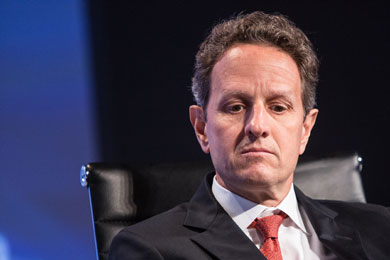Treasury Secretary Timothy Geithner is testifying on Capitol
Hill this week and he’s sure
to be grilled on what he knew about manipulation
of the Libor, a critical international interest rate.
Geithner has said that as
far back as 2007, U.S. regulators, including the New York Fed, which Geithner then
headed, realized that the Libor-setting process “was impaired and flawed and vulnerable to misrepresentation,” and talked with British regulators in 2008 about reforms.
Geithner and Fed Chairman Ben
Bernanke have also said they were
unaware of the potentially criminal cases in which traders
manipulated rates to boost profits. But they did know banks were submitting
artificially low rates during the financial crisis to make it seem like they
were in better shape than they were.
Both the New York
Fed and the Bank of
England have recently released emails and other documents suggesting that
they knew Libor could be gamed and was at best not reliable. Here’s a timeline laying out how the New
York Fed and the Bank of England handled evidence of Libor manipulation back during
the financial crisis.
To see the relevant documents, click on the accompanying quote.
Aug. 28, 2007
An email from a Barclays employee to many recipients, including NY Fed officials, notes that Libor submissions are low and probably not based on rates at which banks could actually borrow. Several other mass emails from the fall of 2007 noted low Libors.
Dec. 17, 2007
An unnamed Barclays employees describes rocky market conditions, and implies that Libors are not reflecting them.
April. 11, 2008
A Barclays employee tells an NY Fed analyst researching Libor problems that the bank is reporting low rates to “fit in with the rest of the crowd.” When Barclays’ posted more honest rates, the employee said, they got negative press inferring they were in worse shape than other banks. The analyst reported the conversation to senior NY Fed management.
April. 11, 2008
The NY Fed’s weekly briefing describes questions about Libor’s accuracy. It is circulated to officials at other Federal Reserve banks and the U.S. Treasury.
April 16, 2008
A Wall Street Journal article reports that banks may be low-balling their Libor submissions to avoid looking weak. That day, according to Bank of England documents, the British Bankers Association, or BBA, the industry group that oversees the Libor, warned banks to submit honest rates.
May 4, 2008
Conversation in Basel
Giethner and the Governor of the Bank of England, Mervyn King, discuss Libor problems in person.
May 6, 2008
New York Fed briefs U.S. Treasury
The NY Fed briefs U.S. Treasury officials on concerns about the Libor. On May 1st, they had also discussed it with the heads of regulatory agencies that make up the President’s Working Group on Financial Markets.
May 20, 2008
A New York Fed report on Libor problems, which is shared with senior officials at the regulator.
May 20, 2008
Internal Bank of England email recounts a BBA discussion of possible Libor reforms.
May 30, 2008
BBA announces it will strengthen oversight of Libor. In an internal bank email, Bank of England head King says that the BBA response “seems wholly inadequate.” Over the next few days, the BBA shares a draft plan for Libor reform with Bank of England and NY Fed officials.
June 1, 2008
Geithner emails King with recommendations “for Enhancing the Credibility of Libor,” including adding more banks to the panel, increased transparency and oversight from the BBA, and randomizing and anonymizing the submission process so that banks did not worry about being outliers. Two days later, King wrote that the suggestions “seem sensible” and that they would ask the BBA to consider them. The Bank of England says that this is the only document concerning Libor manipulation that the NY Fed shared with them.
June 2, 2008
NY Fed official William Dudley, now its president, emails Bank of England deputy governor Paul Tucker, on the BBA’s proposed reforms.
June 2, 2008
In emails, the BBA appears to be pushing for more involvement from central banks. The group now says it wanted the Bank of England to play a “formal role” in Libor oversight, and to ask the UK’s Financial Services Authority and U.S. regulators to join oversight efforts as well. The Bank of England indicated in its discussions that it did not want a formal role in the Libor.
June 10, 2008
The BBA publishes a report asking for input on improving Libor submissions. It did not include all of the NY Fed’s specific recommendations.
June 26, 2008
A Bank of England memo on the BBA proposal reiterates that they don’t feel it is appropriate for the Bank of England to get involved in an industry rate. Otherwise, Bank officials said they found the proposal satisfactory, and thought that the Fed did, too.
Oct. 24, 2008
the problem is that the market so desperately wants Libors down it’s actually putting wrong rates in
A Barclays employee tells an NY Fed analyst that Libor submissions continue to be too low, calling one example “absolute rubbish.”
Oct. 29, 2008
Barclays CEO Bob Diamond recounts in an email a conversation he had with Paul Turner, deputy head of Bank of England. Other Barclays’ managers interpreted this conversation as an instruction from the Bank of England to set Libor rates lower.
Dec. 18, 2008
BBA publishes a final set of recommendations on Libor oversight. As for the role of central banks, the report says “the committee will have arrangements in place for liason with statutory authorities, particularly central banks.”
June 27, 2012
Barclays settles with the U.S. Department of Justice, Commodity Futures Trading Commission, and the British Financial Services Agency over allegations of rate-rigging by specific traders and for low-balling Libor rates during the crisis.











